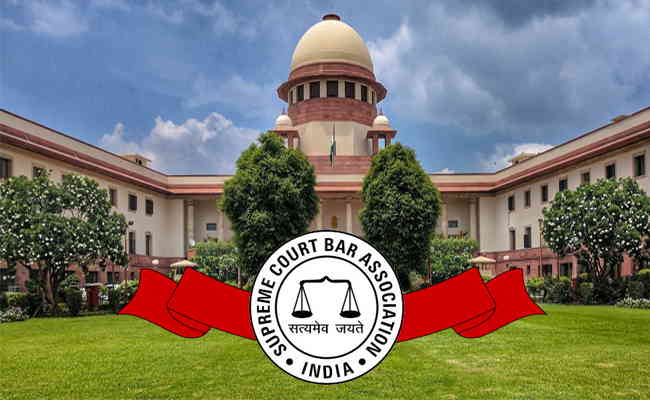The Supreme Court on Friday issued a host of directions to enhance safety and security in courts and towards the digitisation of courtrooms across the country. [Prayuman Bisht v. Union of India]
A bench of Justices S Ravindra Bhat and Dipankar Datta stressed that the safety and security of stakeholders in the judicial system are non-negotiable.
The Court expressed that it was appalled that the courts in Delhi, being the national capital itself, has witnessed at lease three major incidents of gunfire over the past year.
“Would not hope for the litigants who visit the temples of justice dwindle, if the very halls of justice lack the shield of security? How can the litigants secure justice for them when those entrusted to render justice are themselves insecure? These are questions which disturb us to no end, considering certain recent happenings involving firing of gun shots within the precincts of courts in India. It is appalling that court premises in the national capital itself, in the past year or so, have witnessed at least three major incidents of gunfire,” the Court said.
The bench added that the mere installation of CCTV cameras may not be enough to tackle such incidents.
Rather, something more is required in the public interest to monitor activities that compromise the safety and security in court complexes, the Court said.
The Court further noted that there were immediate measures that must be carried out to address the issue, apart from long term solutions that may be implemented over time.
The bench proceeded to issue a slew of directions on this aspect.
The order was also directed to be sent to the Registrars General of each High Court for timely corrective intervention under the supervision of the Chief Justices. Each High Court was directed to submit action-taken reports with respect to the above guidelines by October 10, 2023.
Guidelines issued
Under the heading ‘security measures’, the apex court issued the following guidelines:
a) There ought to be a security plan in place to be prepared by High Courts in consultation with the Principal Secretaries, Home Departments of each State government and the Director Generals of Police of the States/Union Territories or the Commissioners of Police wherever a court complex is within the jurisdiction of a Police Commissionerate. This security plan should be implemented in a timely manner at the State and district levels covering District Headquarters and other courts in outlying areas as well.
b) The security plan may include a proposal to set up permanent Court Security Unit(s) in each complex, indicating the strength and source of security personnel including armed/unarmed personnel and supervisory officer(s), the minimum term and mode of deployment, the list of duties and additional financial benefits for such manpower, special modules for training and sensitizing such manpower in matters of court security, etc.
c) The schematics of CCTV camera installation will have to be laid down on a district-wise basis where the respective State Governments should provide the requisite funds for the execution of such a plan in a timely manner.
d) In newly constructed court complexes, there appears to be a lack of consistency regarding the installation of CCTV cameras – whether it should be done before or after inauguration. “We emphasize that the installation of CCTV cameras should be an integral part of the construction project of courts, and therefore should be prioritized,” the Court said.
e) To address concerns regarding data and privacy, the High Courts may take appropriate measures or draft necessary guidelines in this regard.
f) Upon the finalisation of a security plan, the High Courts may entrust the responsibility of installation and maintenance of the CCTV cameras with the concerned District and Sessions Judges for a more realistic analysis of local requirements.
g) Keeping in mind the lax security measures at entry-exit points within several court complexes, the Court has recommended that such entry-exit points may be secured by constant monitoring with the help of adequate security equipment. The courts may consider putting in place security measures such as deployment of adequate police personnel, security stickers for vehicles, frisking, metal detectors, baggage scanners, court-specific entry passes, and biometric devices to enhance overall security. Other security measures may include regulating the use of court premises as thoroughfares, if necessary, even by way of total prohibition.
h) The relevant authorities may keep a strict check on the permissions required for the continued operations of shops and vendors in court permises, in view of concerns that these operations may potentially lead to security lapses.
i) It may be ensured that emergency measures like ambulances, medical facilities and firefighting services are immediately available and modernised within court complexes and unimpeded access to such vehicles to the premises is assured at all times. This includes ensuring unhindered movement and keeping the court complex vicinity free from traffic and parking congestion.
The Court proceeded to note that it has stressed on the need for digitisation of judicial infrastructure, particularly at district levels, multiple times.
The Court was further informed that there were many courts that lacked the facilities to live-stream court proceedings or record trials. The Court has now urged that these aspects are looked into “in the right earnest” by the concerned High Courts.
The Court added that there is a need to implement fresh and innovative ideas, as part of a futuristic vision, to avoid untoward incidents in courts.
“Initiatives like Audiovisual (AV) technology/Videoconferencing (VC) facility for recording of evidence and testimonies in trial, live-streaming of court proceedings at all levels, establishing e-SEWA Kendras, particularly in remote areas may also be considered accordingly,” the Court said.
The apex court also flagged the fact that court management system committees in many courts are dysfunctional, and that the technology has not sufficiently penetrated in district-level courts yet.
“While we are not presently called upon to scrutinise the functioning of the court management system committees, we nonetheless deem it expedient to observe that the services of these committees could be of utility since it is court management which is under consideration. While the pandemic caused by COVID-19 has accelerated the penetration of technology in courts, considerable work needs to be yet accomplished, particularly at the district and the taluka levels,” the Court said.
The order came in a batch of pleas concerning the safety of judges and security measures in courtrooms across the country.
One of the pleas was a suo motu case registered in the wake of the death of Dhanbad Additional District and Sessions judge Uttam Anand, who passed away after a vehicle rammed into him while he was out on a morning walk in 2021.
Another petition was by one Pradyuman Bisht, who had prayed for the installation of CCTV cameras in all courts and tribunals.
A plea by advocate Vishal Tiwari was also filed in light of an attack on a Bihar judge. Tiwari had submitted that attacks and assault upon judges and magistrates by the police not only lowers the dignity of the judiciary but also raises questions of public safety.
Senior Advocate Sidharth Luthra assisted the Court as Amicus Curiae.
Source Link




